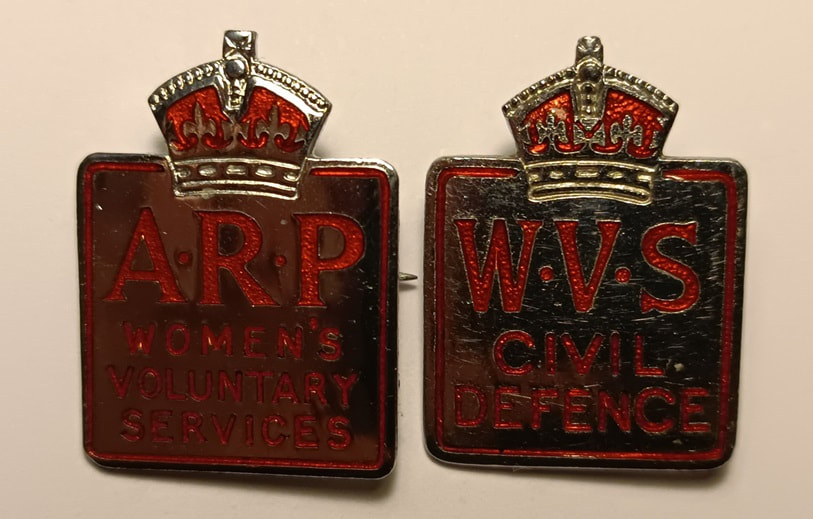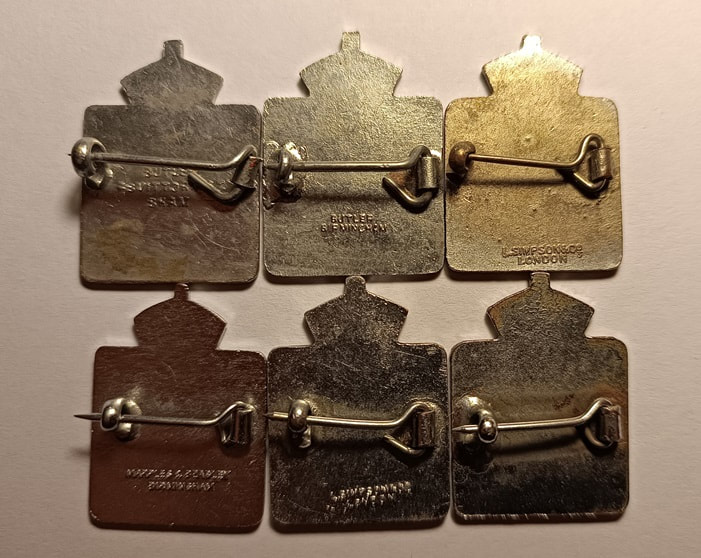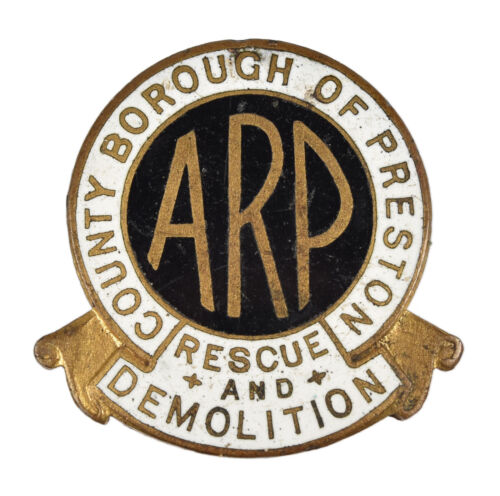|
Previously, I requested information about the "Hitler Hate Club" badges. I had a recent reply from Richard Briggs which I thought worthy of a standalone blog rather than just leaving as a comment on the original post.
"I am aware that nearly 600 of these badges were found in an attic in a house in Jersey. A friend of mine bought the entire collection from the chap that found them in or around 1998. I presume they were local to Jersey residents and once occupied by the Germans were hidden away. He sold most of them over the years and I have the last remaining 47. There were mainly half moon buttonhole backed but there were a few pin back which we assume were for ladies."
0 Comments
Aside from big bidding, the recent online sale of a City of Lincoln Raid Welfare badge for more than £110 perhaps shows a sign of the gradual appreciation of what has often been viewed as one of the less glamorous - if that’s the right word - of the ARP and CD services. Apart from a famous scene where a rest centre is blown up in the 1969 epic film Battle of Britain, the post-raid/raid welfare services are often overlooked in post-war retellings of the Blitz, even though they played a vital role. But, perhaps surprisingly, that’s not just a modern-day omission – it was also an oversight at the time. Whilst preparations had been planned for up to four years before the war, as the title Air Raid Precautions suggests, most consideration had gone into measures before and during air attack, such as shelters, gas masks, response services etc, with little consideration into what happened after the all clear. Taking Leicester as an example, astonishingly, records reveal the Midlands city’s post-raid services were formed only as an afterthought, following the main Blitz. At the war’s start, it was simply suggested Leicester’s parks be kept open during raids, where those bombed-out could congregate. Whilst some church halls etc. provided temporary shelter for the homeless when the city suffered its main blitz in November 1940, it was only two months afterwards that Leicester’s ARP Controller announced in the local press that the city’s post-raid provision had been 're-modelled to cope with air attack'. Records then show a swing throughout 1941 from the previous focus on ARP to post-raid services, with development of the city’s rest centres, emergency feeding centres and other forms of assistance. And this was not just limited to Leicester, but can be seen across Britain: indeed, the term 'ARP' was largely replaced with the broader 'Civil Defence' (CD) in September 1941. With each city requiring thousands of personnel to staff the various refuges and feeding stations, the post-raid services eventually became one of the biggest branches of CD. Yet, due to clothing restrictions, most members were not entitled to standard CD uniform. Instead, they were issued with a standard national Rest Centre Service pin badge. However, as we have seen, rest centres were only one part of the post-raid welfare services, so some areas recognised this with the issue of a different enamel badge. The most prominent was No.3 (North Midlands) CD Region, comprising Lincolnshire, Derbyshire, Nottinghamshire, Leicestershire and Northamptonshire. At a meeting of Leicester CD Committee on September 16, 1942, it was reported: "Regarding the issue of a new type of national badge to Rest Centre volunteers. An initial supply of 600 badges has been requested, which will be issued free, but subject to payment by the volunteer of 1/- [£2.75] in the event of loss. 'However, issue of the new badge makes no provision for remaining volunteers in the Post-Raid Welfare Services and the adoption of a local badge is recommended. A specimen is submitted, which can be purchased for 1/2d [£2] each." Initially an order for 800 badges was made: however, about a month later, it was ascertained at least 1,736 were needed: "An amended estimate has been obtained from Messrs. Fattorini Ltd for the larger supplies at the rate of 11d [£2.50] per badge. 3,000 passes for Welfare Service volunteers (including Rest Centre personnel) will be required, costing £8.10.0d [£450]. Total cost of badges and passes is £100.3.4d [£5,280]." Other CD Committees in the region also purchased enamel badges, most notably in Lincolnshire, with the designs all fairly similar. Around the year 2000, I recall it was said that a carrier bag full of hundreds of County Borough of Grimsby Raid Welfare badges had been discovered and they remain the most commonly seen today, fetching around £10. For years, there was little interest amongst collectors in these raid welfare badges (and armbands and paperwork) and they were not really a seller. However, the badges for other areas of Lincolnshire, such as Holland, Lindsey, Kesteven and Lincoln, are comparatively scarcer and, with the recent rocketing appreciation in Home Front militaria, as we have seen last week, prices have risen, with the average badge around £50. This mirrors a rise in sums paid for items relating to that other overlooked Cinderella CD service, the Fire Guard. So, perhaps, together with the post-raid services, recognition and credit is finally being paid.
Information for the above blog has been drawn from Tested By Bomb And Flame: Leicester Versus Luftwaffe Air Raids, 1939-1945 by Austin J. Ruddy, Halsgrove Books, 2014. To encourage women to become involved in ARP, the Women’s Voluntary Services for Air Raid Precautions was set up in 1938. The short-lived “ARP Women’s Voluntary Services” was issued up to February 1939. It was a chromium plated on brass badge with inlaid enamel and it appears all examples were manufactured by H. B. SALE of Birmingham. It appears the badges were issued in plain, unmarked cream or white coloured card boxes. The role of WVS expanded greatly beyond just ARP matters prior to the war. A change in the name of the organisation occurred in February 1939 when it became the Women’s Voluntary Services for Civil Defence.
Probably as ubiquitous as the silver and base metal ARP badges, the “WVS Civil Defence” badge is often encountered at militaria sales, car boot sales and elsewhere. Due to its availability, it’s often overlooked. It appears the badge was produced throughout the war, and several manufacturers are known. It is assumed that the examples inlaid with red paint replaced the enamel varieties as a war economy measure. Inlaid enamel versions can be found made by: - H. B. SALE B’HAM (Henry Bailey Sale opened his works in the city of Birmingham in 1862) - BUTLER 48 VITTORIA ST. B’HAM (T. A. Butler & Co. were medallists that occupied numbers 48, 50 and 52 Vittoria Street) - BUTLER BIRMINGHAM - MARPLES & BEASLEY BIRMINGHAM (the founders sold their company in 1936 but the trade continued) Painted examples bear two marks: - L. SIMPSON & CO LONDON - Unmarked plain rear An interesting badge made by Thomas Fattorini for the County Borough of Preston's ARP Rescue & Demolition personnel. The use of 'demolition' on wartime badges is quite rare. Probably an early war example before the introduction of Light Rescue and Heavy Rescue Squads (the former rescued casualties while the latter ensured buildings were safe to enter (using shoring etc.)or were pulled down if unsafe).
Vital to the war effort was the manufacture and use of various rubber products. Dunlop Rubber, one of Britain's largest multinational companies by 1939, was at the forefront of this effort. Fort Dunlop, in the Erdington district of Birmingham, was the location of the original tyre factory and the company's main office. Thousands of employees worked at the site.
Accordingly, the business organised a large-scale internal ARP system and a large number of ARP badges can be found featuring Dunlop. Various colours are found, which possibly relate to different functions within the ARP services: wardens, rescue, control, fire and first aid. To date, no definitive record has been located that answers which colour badge was attributed to which ARP service. The badges are quite small (smaller than a £1 coin) and are made in sterling silver. An identical design of the badge features "INDIA", a Scottish rubber company that Dunlop acquired in 1940. Thanks to Adam for the image. |
Please support this website's running costs and keep it advert free
Categories
All
Archives
June 2024
|
|
|
Copyright © 2018–2024
|









 RSS Feed
RSS Feed